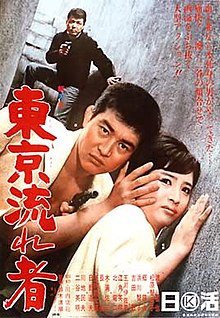Tokyo Drifter
| Tokyo Drifter | |
|---|---|

Theatrical poster
|
|
| Directed by | Seijun Suzuki |
| Produced by | Tetsuro Nakagawa |
| Written by | Yasunori Kawauchi |
| Starring |
Tetsuya Watari Chieko Matsubara Hideaki Nitani |
| Music by | Hajime Kaburagi |
| Cinematography | Shigeyoshi Mine |
| Edited by | Shinya Inoue |
|
Production
company |
|
|
Release date
|
April 10, 1966 |
|
Running time
|
83 minutes |
| Country | Japan |
| Language | Japanese |
| Budget | US$20 million |
Tokyo Drifter (東京流れ者 Tōkyō nagaremono?) is a 1966 yakuza film directed by Seijun Suzuki. The story follows Tetsuya Watari as the reformed yakuza hitman "Phoenix" Tetsu who is forced to roam Japan avoiding execution by rival gangs.
Tetsuya "Phoenix Tetsu" Hondo is a member of a recently deactivated Yakuza gang. His boss, to whom he holds absolute loyalty, Kurata, has given up the life of crime for himself and his syndicate. Otsuka, a rival gang boss, attempts to recruit Tetsu into his organization, but is turned down. After failing, Otsuka sends an assassin to neutralize Tetsu, fearing he will interfere with a real estate scam. Looking to profit from the scheme himself and fearing that his group is threatened by his presence, Kurata asks Tetsu to leave and live the life of a drifter.
Otsuka and Kurata join forces, and assign the successful hitman, "Viper" Tatsuzo, to kill Tetsu. Tetsu evades Viper and his hit squad a number of times and arrives at the establishment of Umetani, an ally of boss Kurata. Tetsu returns to Tokyo, confronting his boss who betrayed him. He kills everyone in the room besides his boss and former girlfriend. At the end of the movie, Kurata kills himself, and Tetsu rejects his former girlfriend Chiharu's plea to allow her to accompany him on his travels. He exits down a pure white hallway, explaining that he has a new allegiance to the wanderer lifestyle, and cannot abandon it for the company of another.
Nikkatsu bosses had been warning Suzuki to tone down his bizarre visual style for years and drastically reduced Tokyo Drifter's budget in hopes of getting results. This had the opposite effect in that Suzuki and art director Takeo Kimura pushed themselves to new heights of surrealism and absurdity. The studio's next move was to impose the further restriction of filming in black and white on his next two films, which again Suzuki met with even greater bizarreness culminating in his dismissal for "incomprehensibility".
...
Wikipedia
